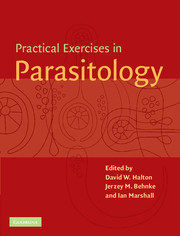Book contents
- Frontmatter
- Contents
- List of contributors
- Preface
- General advice
- 1 Observational Exercises on Parasites
- 2 Ecology
- 3 Physiology and Biochemistry
- 4 Pathology and Immunology
- 5 Chemotherapy
- 6 Molecular Parasitology
- 6.1 Purification of DNA
- 6.2 DNA digestion and gel electrophoresis
- 6.3 Restriction enzyme mapping
- 6.4 Construction of a genomic library
- 6.5 Detection and differentiation of Entamoeba histolytica and E. dispar by PCR
- 6.6 Differentiation between parasite species by agglutination and detection of parasite surface carbohydrates, using non-conjugated lectins
- 6.7 Tentative identification of parasite and tissue surface carbohydrates by conjugated lectins
- 7 Behaviour
- Appendix 1 Reagent index
- Appendix 2 UK suppliers
- Appendix 3 US suppliers
- Index
6.7 - Tentative identification of parasite and tissue surface carbohydrates by conjugated lectins
Published online by Cambridge University Press: 05 June 2012
- Frontmatter
- Contents
- List of contributors
- Preface
- General advice
- 1 Observational Exercises on Parasites
- 2 Ecology
- 3 Physiology and Biochemistry
- 4 Pathology and Immunology
- 5 Chemotherapy
- 6 Molecular Parasitology
- 6.1 Purification of DNA
- 6.2 DNA digestion and gel electrophoresis
- 6.3 Restriction enzyme mapping
- 6.4 Construction of a genomic library
- 6.5 Detection and differentiation of Entamoeba histolytica and E. dispar by PCR
- 6.6 Differentiation between parasite species by agglutination and detection of parasite surface carbohydrates, using non-conjugated lectins
- 6.7 Tentative identification of parasite and tissue surface carbohydrates by conjugated lectins
- 7 Behaviour
- Appendix 1 Reagent index
- Appendix 2 UK suppliers
- Appendix 3 US suppliers
- Index
Summary
Aims and objectives
Using commercial conjugated lectins, these two exercises aim to:
Detect and ascertain surface membrane carbohydrates on trypanosomes and insect vector salivary glands.
Determine differences in salivary gland surface carbohydrates between Glossina species and between different regions of Anopheles salivary glands.
Introduction
Lectins are proteins, usually glycoproteins, derived from both animal and plant material, that recognise and bind to specific sugar moieties (or certain glycosidic linkages) of polysaccharides, glycoproteins and glycolipids present on cell membrane surfaces or in biological fluids (Lis & Sharon, 1986; Sharon & Lis, 1989). Lectin specificity is usually defined in terms of the monosaccharides or simple oligosaccharides that inhibit precipitation or binding reactions.
In order to detect membrane-bound carbohydrates, commercial lectins have been employed either non-conjugated (for use in agglutination/precipitation reactions) or conjugated with a marker (for use in cell or tissue surface membrane studies). The labels used include fluorescein isothiocyanate (FITC) and enzymes (e.g. peroxidase). These lectin-based techniques encompass the use of light and ultraviolet microscopy (Jacobson & Doyle, 1996).
The surface of intact vector tissues to which parasites may attach in order to undergo morphogenesis during transformation from one life cycle stage to the next, or attachment sites prior to transmission, have been studied (Ingram & Molyneux, 1991). These investigations, in part, enabled detection of carbohydrate moieties on a membrane surface that might act as binding sites to facilitate parasite adhesion.
- Type
- Chapter
- Information
- Practical Exercises in Parasitology , pp. 385 - 394Publisher: Cambridge University PressPrint publication year: 2001



